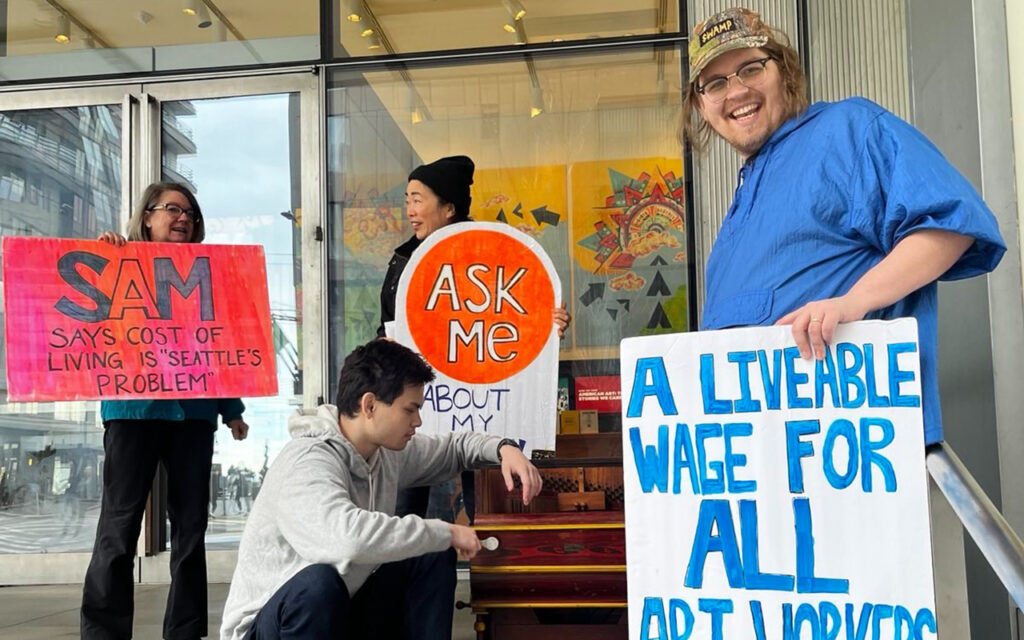[ad_1]

Recently, I’ve entered my 11th year as a gallery guard at the Seattle Art Museum (SAM). Since 2022, I’ve also been a member of the SAM Visitor Service Officers (VSO) Union, where we have been working to organize gallery guards to achieve better wages, restoration of our retirement benefits, and greater worker protections at the museum. In recent weeks, after 27 months of contract delays by SAM, negotiations have reached a breaking point, and workers have had no choice but to take drastic measures.
Our union is independent, which means we are worker-run and organized, but this was not by choice. The National Labor Relations Board, even under the Biden administration, failed to protect our right to affiliate with a national union. The museum’s Board of Trustees took advantage of a legal loophole around “security workers” in the National Labor Relations Act to stop our affiliation with International Union of Painters and Allied Trades (IUPAT) Local 116 in 2022. This move deprived us of the funds, legal support, and infrastructure that partnering with a large union provides.
On the positive side, this also more quickly exposed that the Board’s interests and incentives run counter to the needs of SAM employees.

We know that the SAM Board comprises some of the wealthiest people in Seattle, and that they derive benefits from being on the Board. For example, Board members profit financially from their association with museums in numerous ways, one of which is increasing the value of their personal art collections. Several also leverage their so-called “philanthropy” at our arts institutions to launder their corporate reputations and ties to environmentally damaging industries. This reputation of benevolence is then often exploited for political power. Additionally, donors have a huge amount of control over how their funds are used, meaning that in many cases, personal projects can be pursued through the museum’s nonprofit structure.
Museums offer some of the best “bang for your buck” in benefits, as far as philanthropy goes. However, the situation is changing with the growth of the museum union movement, which has responded to income inequality and the housing crisis nationwide.
In the past, many donors could earmark donations exclusively for personal museum projects, and worker compensation stayed out of their sight. But because conditions in the US have worsened for working people, museum employees no longer do it as a “fun, part-time job,” but rather for survival. This year, the cost of living in Seattle has become unmanageably expensive. It costs about $33 per hour to rent a one-bedroom apartment in Seattle in 2024, according to the National Low Income Housing Coalition.
Amid these conditions, why won’t the SAM Board of Trustees support their employees? The museum’s bargaining rep stated in November of 2023, via an emailed response to the VSO Union request for information, “The Employer has never asserted, nor will it ever assert, either a present inability to pay, or a prospective inability to pay during the life of the contract being negotiated.” Rather, they explained that while SAM has ample finances (assets of around $360 million, according to the 2021 IRS form 990), it has difficulty maintaining existing properties, and property upkeep will continue to take precedence.

This explanation would have carried more weight if the museum had not announced in January they would be pursuing further expansion.
SAM’s most recent five-year strategic plan includes plans to “develop” the collection, exhibition programs, and gallery spaces. Board Member Jon Shirley, a major art collector and former president, CEO, and director of the tech giant Microsoft, said in a 2018 interview that showcasing his Alexander Calder collection “takes a lot of room,” and suggested “taking down the floors above it” to create additional space “because we own those floors.” Shirley also led the development of the Olympic Sculpture Park (OSP) in 2007, one of SAM’s most ambitious expansions which also became the city’s largest greenspace.
But as SAM’s operations expanded to include OSP during this same period, the institution dealt its workers a blow they have yet to recover from. Around 2006, the museum Board terminated the pension program for SAM’s frontline workers. Shirley, who was Board president at the time, allocated his donations toward his passion: creating a space to display his Calder collection. And the workers suffered greatly for it. In prior years, we had earned a pension benefit that allowed workers to retire with dignity, instead of being forced to work past retirement age. Sadly, the Board continues to chip away at our current, insufficient retirement benefits.

In the bargaining room, SAM continues to claim that with further expansions and upgrades, the museum may someday become more profitable; and if it does, security guards should trust that these future benefits will be passed on to its workers.
But instead of waiting for those benefits to trickle down, our union authorized a strike vote last month, with 96% of votes in favor. We plan to go on strike beginning this Friday, November 29, unless SAM’s Board of Trustees changes course and offers a contract that allows its workers to survive in Seattle. For two years, the Board has refused outright to meet with us, so now we take the argument directly to them.
On November 19, we held a rally at our museum during the VIP preview of Shirley’s second Calder show this year. We sent our message to the Board loud and clear: Art institutions need to stop acting “symbolically,” and start supporting their employees for real.
[ad_2]
Source link

